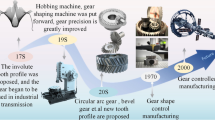Abstract
The primary objective of this article is to establish the computing theory to investigate the curvature interference characteristic of the conical worm gear of a conical surface enveloping conical worm gearing. The tooth surface equations, the meshing function, the curvature interference limit function of the conical worm gearing and so on, are all derived strictly. An approach to compute the curvature interference limit line is proposed according to the elimination and geometric construction. This method can be utilized to judge the existence of the limit line and can also provide the reasonable guess value for the following iteration. The solution domain of the limit line should be roughly identical to that of the conjugated zone of the worm gearing. The numerical results show that there is one significative limit line on each flank of one tooth of the gear, which generally does not enter into the gear tooth surface. The two flanks of the worm gear are all located on the non-curvature-interference side of the limit line. Therefore, the undercutting of the gear seldom takes place. Nevertheless, the limit line on the concave tooth surface is nearer to its toe. The influences of main designing parameters on the curvature interference limit line are analyzed systematically, and the obtained results indicate that the toe and the dedendum of the worm gear concave tooth surface have the greatest potential hazard to be undercut.
Zusammenfassung
Das Hauptziel dieses Artikels ist die Etablierung der Berechnungstheorie zur Untersuchung der Krümmungsinterferenzcharakteristik des konischen Schneckengetriebes, die Verzahnung mit einer konischen Oberflächen. Die Zahnoberflächengleichungen, die Eingriffsfunktion, die Krümmungsinterferenzgrenzfunktion des Kegelschneckengetriebes usw. werden alle streng abgeleitet. Ein Ansatz zur Berechnung der Grenzlinie der Krümmungsinterferenz wird gemäß der Eliminierung bzw. der geometrischen Konstruktion vorgeschlagen. Dieses Verfahren kann verwendet werden, um das Vorhandensein der Grenzlinie zu beurteilen, auch den vernünftigen Schätzwert für die folgende Iteration zu liefern. Die Lösungsdomäne der Grenzlinie sollte mit der des konjugierten Bereichs auf der Zahnoberfläche ähnlich sein. Die numerischen Ergebnisse zeigen, dass es an jeder Flanke eines Zahns des Zahns eine eindeutige Grenzlinie gibt, die im Allgemeinen nicht in die Zahnoberfläche des Zahns eintritt. Die beiden Flanken des Schneckengetriebes befinden sich alle auf der Nichtkrümmungsinterferenzseite der Grenzlinie. Daher erfolgt selten eine Unterätzung des Getriebes. Trotzdem ist die Grenzlinie auf der konkaven Zahnoberfläche näher der Spitze. Die Einflüsse der wichtigsten Auslegungsparameter auf die Grenzlinie der Krümmungsstörung werden systematisch analysiert, und die erzielten Ergebnisse zeigen, dass die konkave Zahnoberfläche des Schneckenrads die größte potenzielle Gefahr aufweist, unterschnitten zu werden.













Similar content being viewed by others
References
Zhao Y, Kong X (2018) Meshing principle of conical surface enveloping spiroid drive. Mech Mach Theory 123:1–26
Illés Dudás (2004) The Theory and practice of worm gear drives. Penton Press, London
Zhao Y (2017) Axial tooth profile of conical surface enveloping spiroid. In: Proceedings of The JSME International Conference on Motion and Power Transmissions (MPT2017-Kyoto), Kyoto, 28. February–3. March, 2017, Japan Society of Mechanical Engineers (JSME), Tokyo
Zhao Y, Meng Q (2017) Curvature interference characteristic of conical surface enveloping conical worm. Forschung im Ingenieurwesen 81:409–419
Zhao Y, Meng Q (2018) Characteristics of the meshing limit line of conical surface enveloping conical worm drive. Proceedings of The 2018 International Gear Conference, Lyon, 27–29. August, 2018, INSA Lyon
Dong X (1989) Foundation of meshing theory for gears. China Machine Press, Beijing
Litvin FL, Fuentes A (2004) Gear geometry and applied theory, second ed. Cambridge University Press, New York
Dong X et al. (1987) Worm drives design. China Machine Press, Beijing
Litvin FL (1997) Development of gear technology and theory of gearing. NASA Reference Publication, Cleveland
Zhang Y, Xu H (2003) Pitch cone design and avoidance of contact envelope and tooth undercutting for conical worm gear drives. Asme J Mech Des 125:169–177
Radzevich SP (2012) Dudley’s handbook of practical gear design and manufacture, second ed. CRC Press, Taylor & Francis Group, Boca Raton
Weihuan Chen (2006) Differential geometry. Peking University Press, Beijing
Wu D (1986) Lectures on differential geometry. People’s Education. Press, Beijing
Wu D (1985) Jiashun Luo. Principle of gear meshing. Science Press, Beijing
Zhao Y, Zhang Y (2017) Computing method for induced curvature parameters based on normal vector of instantaneous contact line and its application to Hindley worm pair. Advances in Mechanical Engineering 9(10):1–15
Funding
This study was funded by the Open Fund of the Key Laboratory for Metallurgical Equipment and Control of Ministry of Education in Wuhan University of Science and Technology (2018B05) and the National Natural Science Foundation of China (51475083).
Author information
Authors and Affiliations
Corresponding author
Rights and permissions
About this article
Cite this article
Meng, Q., Zhao, Y. & Yang, Z. Curvature interference characteristic of conical worm gear. Forsch Ingenieurwes 83, 759–773 (2019). https://doi.org/10.1007/s10010-019-00372-3
Received:
Accepted:
Published:
Issue Date:
DOI: https://doi.org/10.1007/s10010-019-00372-3




